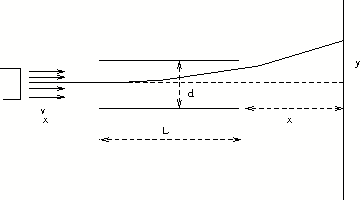[1] An electron moving with speed of \(5.0\times 10^8\)cm/sec is shot parallel to an electric field strength of \(1.0\times 10^3\)nt/coul arranged so as to retard its motion.
- How far will the electron travel in the field before coming (momentarily) to rest ?
- how much time will elapse?
- If the electric field ends abruptly after \(0.8\) cm, what fraction of its initial energy will the electron loose in traversing the field? em-que-01001
[2] If an ink drop has a mass of \(50\times10^{-9}\) g and is given a charge of \(-200\times 10^{-15}\) C, find vertical displacement in an inkjet printer with 3keV deflection potential, 3mm plate separation and 15 mm deflection plate length. The nozzle ejects the drop with velocity 25 m sec\(^{-1}\) and leaving edge of the deflection plate is at a distance 15 mm from the paper.
em-que-01002
[3] Two similar balls of mass \(m\) are hung from silk threads of length \(\ell\) and carry equal charges q. Assuming \(\theta\) to be small show that the separation, \(x\), betweeen the balls is given by
\[x\approx \frac{q^2\ell}{2\pi\epsilon_0 mg} .\]
What is the value of \(q\) if \(\ell=120\)cm, \(m=10\)gm, \(x=5\)cm ?
em-que-01003
[4] A gold nucleus contains a positive charge equal to that of 79 protons. An \(\alpha\) particle, \(Z=2\), has kinetic energy \(K\) at points far away from the nucleus and is traveling directly towards the charge, the particle just touches the surface of the charge and is reversed in direction. relate \(K\) to the radius of the gold nucleus. Find the numerical value of kinetic energy in MeV is the radius \(R\) is given to be \(5 \times10^{-15}\) m.
[ 1 MeV = \(10^6\) eV and 1 eV = \(1.6\times10^{-16}\)]
em-que-01004
[5] An electron is constrained to move along the axis of a ring of charge \(q\) and radius \(a\). Show that the electron can perform small oscillations along the axis of with time period given by \[T=\frac{1}{2\pi}\frac{4\pi\varepsilon_0 m a^2}{eq}\]
em-que-01009
[6] An alpha particle travels in a circular path of radius \(0.45\)m in a magnetic field with \(B=1.2\)w/m\(^2\). Calculate
(i) its speed
(ii) its period of revolution, and
(iii) its kinetic energy.
[Mass of alpha particle = \(6.64424. 10^{-27}\) kg =3727.4 MeV.]
em-que-01010
Exclude node summary :
Exclude node links:
4727:Diamond Point






 ||Message]
||Message]
